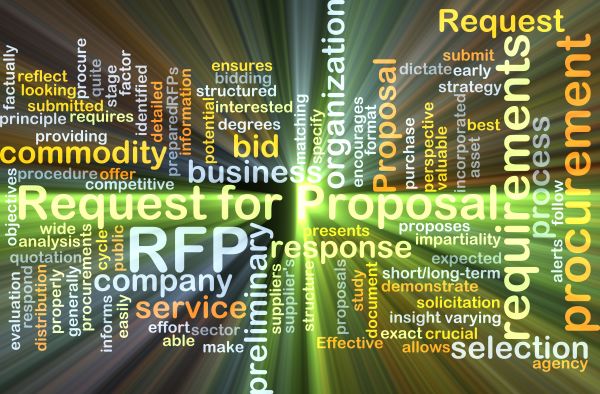Now these distinctions are cleared up, it’s time to get moving on that contract proposal.
Step 1: Do your research

According to Inc., a successful contract proposal is responsive, or clearly shows “the bidder has done his or her homework, [and] is thoroughly familiar with the client’s needs and aspirations.”
The best way to start your research is to meet with key stakeholders and ask them probing questions about what they’re looking for. Some questions you can ask are:
- What are your goals for this project?
- What is your ideal solution?
- What results would you like to see? or How would you determine the success of this project?
- What price range would you like to stay within?
- What are the specifications for this project?
- Do you anticipate any challenges with this project?
- What experience, good and bad, have you had with vendors in the past?
- What made those experiences good? What made them bad?
- Who is our main point of contact?
It’s also important to know your client’s messaging and tone, as this will help when you create your contract proposal. Scour your client’s website and take note of common terminology or phrasing used throughout. Read through their About Us section, if they have it. Peruse their social media channels and read through their posts.
Finally, do a good ol’ Google search for terms related to their business or industry. Take a look at any other companies that show up in your search and note their similarities and differences from your prospect. Check out any recent news related to their industry and consider how it might have an effect on their request.
When you do your homework on your prospect, you’ll be able to read through the lines of their request to better understand what will match their expectations and fulfill their needs for the project in question. It will also show them you’ve spent the time and effort getting to know their business and industry, and you’re truly invested in earning their business.
Step 2: Determine the “voice” of your contract proposal
Your business proposal is your opportunity to convince your buyer that they should choose your business rather than doing it themselves or using a different vendor or resource. However, this isn’t an argument, nor should it be written as if you are talking at the RFP sender.
When creating your contract proposal, approach it conversationally, “as if you were sitting across the table in front of the reader,” says Dr. Elliott Jaffa, a behavioral and marketing psychologist and consultant. “The RFP is written in a language of what I call ‘governmentese,” but you do not have to respond in the same language.”
However, mirroring the language your prospect uses in their RFP can sometimes be beneficial to the success of your contract proposal.
“Whenever possible, use the exact language of the buyer in your opening section,” says Matt Gambino, founder of PROPEL Skills Development. “If the buyer used a catchy phrase in our initial call, like, ‘reps sometimes throw requests over the wall to my sales engineers…’ I’ll use the phrase ‘throw the requests over the wall,’ in the needs section of my proposal.”
Additionally, it’s important to keep the messaging of your contrat proposal client-centered.
“It is important to keep in mind that although the RFP is asking questions about your firm and experience, the response must be client-specific and feel like it was customized for them and their needs,” recommends Danielle Feroleto, owner of the marketing agency, Small Giants.
A good practice to get into, before you even begin drafting the content of your contract proposal, is to place yourself in your prospects shoes. Ask yourself what’s in it for them, and how will your services make their life better by solving their problem? By applying these questions to your research efforts, you should be able to find answers that will resonate with your prospect.
Step 3: Create your contract proposal outline and write your proposal

Once you’ve exhausted research on your prospect and have a fleshed-out idea of the kind of tone your contract proposal will exude, you can start outlining your contract proposal.
While it’s fine to use a premade template for your contract proposal, understand you run the risk of losing customization and originality with the format. If you do go this route, be sure you choose a template specifically made for your kind of business, or at least a business like it. Bidsketch has a wide selection of contract proposal templates based on business types.
Not all businesses are the same, so naturally, not all business proposals will look the same. However, there are some key elements to include in your business proposal to really knock the socks off your prospect.
Title page (optional)
Yes, the title page is technically optional, but also highly recommended. A title page make your contract proposal look clean and well-prepared. It also acts as the first impression of your contract proposal.
Your title page should include the name and contact information of the prospect you’ve prepared the contract proposal for, plus your business’s name, contact information, and logo.
Cover letter
Much like a cover letter for a job application, the cover letter of your business proposal is meant to be an introduction to your business proposal. It should also be persuasive but to-the-point.
In your cover letter, briefly summarize the contents of your business proposal, like important requirements, the solution your business provides, and what your prospect can expect once the job is completed.
Table of contents (optional)
Again, although the table of contents is an optional addition to your business proposal, it’s still a recommended element. It shows organization on your part, and allows the reader to quickly jump to any section of the contract proposal as needed.
Executive summary
Make the executive summary tell your story—not just promise to tell it,” says Diana Booher, owner of Booher Research Institute. The executive summary “should be a complete digest of your conclusions and recommendations—what you propose to do for the client: the what, why, how, and how much.”
Think of the executive summary as your opportunity to present your case as to why you’re the best fit for the job in question. Instead of summarizing your entire contract proposal, focus on the conclusion you want the reader to reach after reading it.
For more information on what to include in an executive summary, check out this helpful article from The Balance.
Problem statement
Remember all that research you did prior to starting this business proposal? Here’s where it’ll really come into play.
“To demonstrate your understanding of the industry, it is important to give a brief overview of general issues that the industry, as a whole, is facing,” recommends Jacob Dayan, CEO and co-founder of Community Tax. While this doesn’t necessarily mean the client is also facing those issues, he says, it allows you to show the prospect where they lie amongst their peers.
“Or, if the client is facing the same industry-wide issues, you can explain why many or all players within the spaces are experiencing the same struggles as the client,” Dayan says.
Any statistics you have about the current landscape your prospect is in can also be used in this portion, but remember to keep your messaging short and to-the-point. You can show your understanding of your prospect’s situation and needs in a paragraph or two. After all, they already know the problems they face. What they’re most interested in is how you plan to help them, what it will take, and how much it might cost.
Proposed solution
Now that you’ve set the scene in the problem statement, it’s time to propose your solution. This is your time to shine!
In your proposed solution, paint a picture for your prospect of how you plan to solve their problem. Think of the “who, what where, when, why, how” questions your prospect will inevitably have, and do your best to address each one.
In your proposed solution, you’ll specifically want to outline your methodology, or approach, to how you plan to tackle the issue. Include as many details as possible, but be sure to be clear, concise, and avoid any jargon, unless referring to language used in the RFP.
You’ll also want to include your qualifications here. Include any relevant education, years of experience, and trainings or certifications that relate to what you offer. After all, if the roles were reversed, wouldn’t you want to make sure the other party knew exactly what they were doing?
Team members (optional)
If there will be more than just yourself working on this project, it may be beneficial to include a brief section in your contract proposal introducing the team members assigned to the project. If anything, be sure it’s clear to the reader who the point of contact will be on your end, should any issues arise.
Schedule and timeline benchmarks
While not all projects have static timelines, it’s helpful to give your prospect an estimated schedule and timeline for when you expect to accomplish the job.
If there are any exceptions (i.e. order time for materials) or important timeline benchmarks to note, make absolute certain to include them. Transparency is important here. It’s better for the prospect to know a realistic timeline ahead of time, rather than to be sorely disappointed when the project takes longer than expected.
Pricing, payment, and legal matters
Although pricing may not be the only thing a requester is looking for when trying to find a solution, it’s certainly top-of-mind.
Generally, it’s good to keep your cost competitive to others. If you aren’t sure where to find that number, it’s always good to ask the requester what their budget is. Additionally, you can reach out to your professional network to find a resource that’s not a direct competitor in your region. Or, if you have one, turn to a trusted mentor or friend in the field and get their input.
It’s expected that the cost might change as things arise, but you should provide your best estimate to what you expect the project to cost. Include a breakdown of the cost for full transparency (i.e. cost per hour, cost of materials, transportation, etc.). If you offer payment plans, this is also where you’ll want to include it.
Finally, if there are any legal specifications to be made (such needs for licenses or permits), you should also make them known here. Spell them out plainly and clearly. Unless your potential client is in the legal field, they probably won’t want to decipher any legal jargon.
Client testimonials (optional)
Client testimonials aren’t necessary, but could prove to be a huge help in your favor. Any kind of social proof to support your claims, such as client testimonials, social media snapshots, or review website clips are all great examples you could include.
Project examples/portfolio (optional)For extra validation of your experience and qualifications, consider adding a few examples from previous projects, especially if they’re similar to the job in question. These can help to further differentiate you from your competitors and cement your business as the best fit for the job.
Visuals (optional)
According to the Washington and Lee Law School, using graphics or illustrations as a visual aid to any text enhances memory retention by 20 percent. Including visuals throughout your proposal can help lock your business in the prospect’s mind apart from the others. However, be tactful with your visuals, and be careful not to go overboard.
Consider using charts or graphs to help your prospect understand the data used in your contract proposal. Or, where applicable, borrow visuals from the prospect’s website or social media channels to show you understand their brand and give them some ownership over the proposal.
Finally, be sure the visuals you include are high-resolution, flow nicely within your contract proposal, and provide extra context to the right subject.
Thanks/conclusion
Conclude your contract proposal by quickly summarizing the important information from your proposal, and thank the prospect for their time and consideration.
The order in which your format and organize your contract proposal will likely vary based on your needs and the requester’s needs. However, be sure to keep your prospect’s needs top of mind.
Feroleto recommends organizing your contract proposal in a similar way was the RFP to make it easier to for the requester to find the information they need.
“Answer each question individually and somewhat separately,” to ensure you maintain consistency across your proposal, she says.
Ultimately, it’s up to you how your format and organize your contract roposal. But if you use these elements as a guideline when drafting your proposal, you’ll be sure to catch and keep your prospect’s attention.
Step 4: Edit, edit, edit

A sure-fire way to ensure your contract proposal gets tossed to the side quickly is to have too many spelling and errors, typos, or misinformation throughout it.
Your ninth grade English teacher didn’t make you write multiple drafts of your essays just for fun. It’s important to go back through the first draft of your contract proposal at least with a metaphorical fine-tooth comb to make sure you catch any errors from the first time around. Trust us on this—even the most successful and prolific writers send their pieces of work through multiple rounds of edits before their best-sellers hit the shelves.
Once you’ve combed through your proposal a couple of times and corrected any errors, ask a colleague or friend familiar with your business to also read through the contract proposal. A fresh set of eyes can sometimes catch things that your own may pass right over, even if you’ve read it a million times.
Step 5: Follow up
So you’ve spent precious time and energy into making your business proposal the best it can be, and you’ve finally shipped it off to the requester by their deadline, if not before. Hopefully you’re feeling pretty good about yourself and the work you’ve done. But the process isn’t over yet.
If you’re lucky, the requester will respond quickly with whether or not they’ve chosen your company for the project. Most likely, however, you’ll hear nothing but crickets regarding their decision until weeks have passed and you’ve already moved on to the next RFP or project. But if you’re proactive about following up with your prospect, you’ll show them your continued investment and interest in their business, increasing your chances of beating out your competitors.
QuoteRoller recommends waiting at least three to five business days before reaching out. However, if you’re using an email or contract proposal tracking tool and notice the prospect has opened the proposal, it’s safe to contact them after a few hours. Check out this blog post from WebStrategies for ideas on what to say in your follow-up.
Another good idea to ensure you stay on top of your prospect follow-up is to automate it. Client management tools like Keap let businesses create email campaigns designed for automatic follow-up. They can be altered and controlled as needed, but remove the extra work of manual follow-up, so you can focus on other parts of your business until you receive your desired response.
Try free
14-day free trial. No credit card required.







